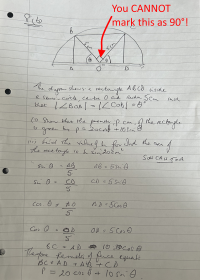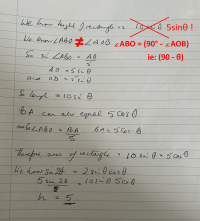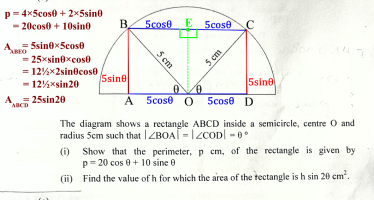reggiwilliams
Junior Member
- Joined
- Mar 6, 2024
- Messages
- 50
Please re-read your very first line.I said height of rectangle was 5 sintheta
Given ABO is a right angled triangle I assumed angles ABO and AOB were equal
Could I ask you for your workings and solution so I can see where I have gone wrong
My first line said height of rectangle was 5 sin theta are you saying that is incorrect?Please re-read your very first line.
In a right triangle, one angle is 90o while the other two angles add up to 90o. The other two angles do not have to be equal. For example, in a right triangle the angles can be 30-60-90 or 20-70-90...
The way it works here is you show us your work and then we guide you to the correct answer. Take into account what I said above and see what you can do with that.
No, you didn't; see page two of my amendments to your answers.I said height of rectangle was 5 sintheta
No, again, see my amendments (to p.2); the triangle is right-angled but not (necessarily) isosceles so you cannot just assume that it is!)Given ABO is a right angled triangle I assumed angles ABO and AOB were equal
It seems to me that the question has been very badly composed!Could I ask you for your workings and solution so I can see where I have gone wrong



You could have saved yourself a lot of paper & ink too.Thanks so much for your help
Agreed it would have been far less confusing if they had used x instead of h.
